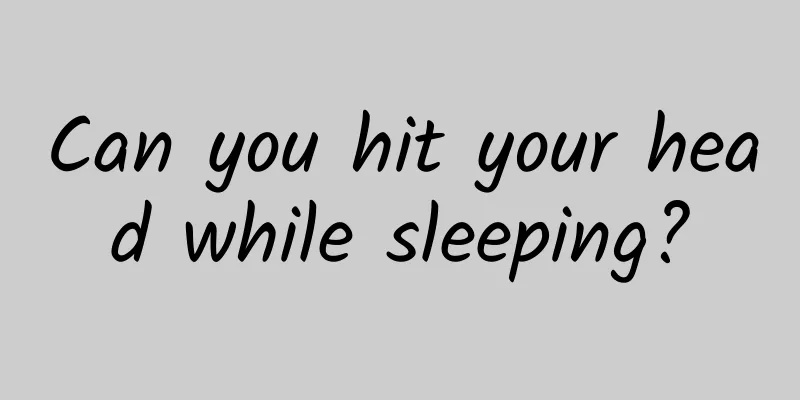Can you hit your head while sleeping?

|
This is the 3979th article of Da Yi Xiao Hu Have you ever heard that you can break your head while sleeping and need to go to the hospital for treatment? Although some people are not very honest when they sleep, and some people kick their hands and feet and move around a lot, it is rare to break your head in life. Today we will learn about a rare sleep disease - sleep-related rhythmic movement disorder. Sleep-related rhythmic movement disorder, also known as "bedtime head shaking", is common in children and is more common in patients with mental retardation and autism. It is a sleep disorder of unknown cause and is classified as sleep-wake transition disorder in the International Classification of Sleep Disorders. 1. What are the symptoms of sleep-related rhythmic movement disorder? The main clinical manifestations of this disease are paroxysmal rhythmic head-banging, head-shaking or trunk-swaying movements. Head-banging is the most common. Repeated impacts can cause serious injuries such as head trauma and carotid artery dissection, and rarely involve the limbs. Each attack lasts from a few minutes to 15 minutes and can occur at any stage of sleep, with several to more than ten attacks per night. In adolescence and adulthood, it may be accompanied by various sleep-related diseases such as restless legs syndrome, obstructive sleep apnea, anxiety and depression, daytime sleepiness, etc., which seriously affect the patient's daily quality of life. Sleep-related rhythmic movement disorder is quite harmful. Patients may disturb their bed partners' sleep during normal sleep. Even worse, head trauma may lead to adverse consequences such as intracranial hemorrhage, so it needs to be taken seriously. 2. What tests are helpful for sleep-related rhythmic movement disorder? Auxiliary examinations for sleep-related rhythmic movement disorders generally include polysomnography, head CT or head MRI to exclude other intracranial lesions, and occasional nonspecific changes in the electroencephalogram. In general, most test results are normal. 3. How to diagnose? What diseases can be differentiated? The diagnosis can refer to the diagnostic criteria for sleep-related rhythmic movement disorder in ICSD-3, but it needs to be differentiated from periodic limb movement disorder and epilepsy. The former is manifested by stereotyped repetitive flexion movements of the legs during sleep, rhythmic extension of the big toe, and dorsiflexion of the ankle joint, which often occurs during light sleep; the latter is generally characterized by cyanosis, clenched teeth, limb rigidity with clonus, and urinary incontinence during attacks, and can be differentiated by epileptic-like discharges on the electroencephalogram. IV. Current status of treatment for sleep-related rhythmic movement disorder The cause of this disease is still unknown, so there are no systematic research reports on related drugs and behavioral treatments. Most children can relieve themselves without treatment. For children and adults with obvious symptoms, low-dose clonazepam has a good effect, but the disadvantage is that it cannot cure it. Tricyclic antidepressants may be effective for rhythmic movement disorders, and water beds may help improve rhythmic movements. Although there is no proper treatment for sleep-related rhythmic movement disorder, the incidence is relatively rare. If you have a friend with this condition, you might want to learn more about it. Author: Associate Professor Man Yuhong, Deputy Chief Physician, Department of Neurology, Second Hospital of Jilin University Author: Jilin University Second Hospital Department of NeurologyMan YuhongChief Physician |
<<: Sand blew into the woman's eyes and she rubbed her contact lens into pieces
Recommend
Can Streptococcus agalactiae be used for vaginal delivery?
In our daily life, there are many types of bacter...
Pubic hair plays a big role, but removing it has hidden dangers
When many girls grow to puberty, their bodies beg...
What should you pay attention to when you are pregnant with a history of miscarriage?
Childbirth is an activity that people must carry ...
Treatment of gonococcal urethritis in women
I recently felt very uncomfortable and went to th...
What should I do if my vaginal discharge is brown and my waist hurts?
I believe everyone is familiar with leucorrhea. I...
Is painless abortion harmful to the human body?
With the rapid development of social economy, var...
Eating something sour before menstruation can help relieve dysmenorrhea
Dysmenorrhea is a problem for many female friends...
What is the hcg value for ectopic pregnancy and can be treated conservatively?
Important reminder: Ectopic pregnancy is the most...
After a medical abortion, my period came and the abortion was completed completely?
Abortion is the last resort for women facing unex...
Feeling cold during menstruation
If you feel cold all over during menstruation, it...
Disadvantages of potato facial mask
Potatoes are not only a common food, but they can...
What to do if vulva is itchy and wet?
For most women, it is quite uncomfortable to endu...
How to eat yam to enlarge breasts? These four ways of eating are the best
As we all know, yam has a very good breast enhanc...
Pediatrician Mom: It’s actually very simple to get the whole family to sleep well
The following article comes from Pediatrician Mom...
What causes chest pain?
Breasts are very important organs for women. Brea...









